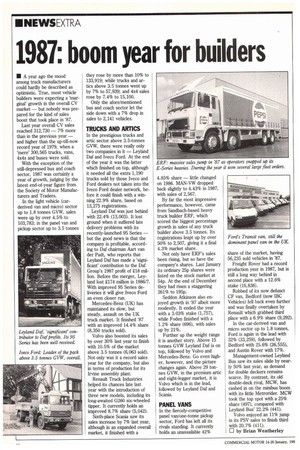1981: boom year for builders
Page 18

If you've noticed an error in this article please click here to report it so we can fix it.
MI A year ago the mood among truck manufacturers could hardly be described as optimistic. True, most vehicle builders were expecting a 'marginal' growth in the overall CV market but nobody was prepared for the kind of sales boost that took place in '87.
Last year overall CV sales reached 312,730 7% more than in the previous year and higher than the up-till-now record year of 1979, when a 'mere' 300,565 trucks, vans, 4x4s and buses were sold.
With the exception of the still-depressed bus and coach sector, 1987 was certainly a year of growth, judging by the latest end-of-year figure from the Society of Motor Manufacturers and Traders.
In the light vehicle (carderived van and micro) sector up to 1.8 tonnes GVW, sales were up by over 4.5% to 103,783; in the panel van and pickup sector up to 3.5 tonnes they rose by more than 10% to 133,919; while trucks and artics above 3.5 tonnes went up by 7% to 57,939; and 4x4 sales rose by 7.4% to 15,100.
Only the afore/mentioned bus and coach sector let the side down with a 7% drop in sales to 2,141 vehicles.
TRUCKS AND ARTICS
In the prestigious trucks and artic sector above 3.5-tonnes GVW, there were really only two companies in it Leyland Daf and Iveco Ford. At the end of the year it was the latter which finished on top, although it needed all the extra 1,190 trucks sold by those Iveco and Ford dealers not taken into the Iveco Ford dealer network, before it could finish with a winning 22.9% share, based on 13,275 registrations.
Leyland Daf was just behind with 22.4% (13,003). It lost ground when it suffered late delivery problems with its recently-launched 95 Series but the good news is that the company is profitable, according to Daf chairman Aart van der Padt, who reports that Leyland Daf has made a 'significant' contribution to the Daf Group's 1987 profit of £18 million. Before the merger, Leyland lost £174 million in 1986/7. With improved 95 Series deliveries it will give Iveco Ford an even closer run.
Mercedes-Benz (UK) has maintained its slow, but steady, assault on the UK truck market. It finished '87 with an improved 14.4% share (8,350 trucks sold).
Volvo also boosted its sales by over 30% last year to finish with 10.5% of the market above 3.5 tonnes (6,063 sold). Not only was it a record sales year for the company, but also in terms of production for its Irvine assembly plant.
Renault Truck Industries helped its chances late last year with the introduction of three new models, including its long-awaited G260 six-wheeled tipper. It currently holds an improved 8.7% share (5,042).
Sixth-place Scalia saw its sales increase by 7% last year, although in an expanded overall market, it finished with a 4.85% share little changed on 1986. MAN-VW dropped back slightly to 4.43% in 1987, with sales of 2,567.
By far the most impressive performance, however, came from Sandbach-based heavy truck builder ERF, which scored the biggest percentage growth in sales of any truck builder above 3.5 tonnes. Its registrations leapt up by over 50% to 2,507, giving it a final 4.3% market share.
Not only have ERF's sales been rising, but so have the company's shares. Last January its ordinary 25p shares were listed on the stock market at 54p. At the end of December they had risen a staggering 261% to 195p.
Seddon Atkinson also enjoyed growth in '87 albeit more modestly. It ended the year with a 3.03% stake (1,757), while Foden finished with a 1.2% share (696), with sales up by 21%.
Further up the weight range it is another story. Above 15 tonnes GVW Leyland Daf is on top, followed by Volvo and Mercedes-Benz. Go even higher, however, and the picture changes again. Above 29 tonnes GVW, in the premium artic and eight-legger market, it is Volvo which is in the lead, followed by Leyland Daf and Scania.
PANEL VANS
In the fiercely-competitive panel van/one-tonne pickup sector, Ford has left all its rivals standing. It currently holds an unassailable 42% share of the market, having 56,235 sold vehicles in '87.
Freight Rover had a record production year in 1987, but is still a long way behind in second place with a 12.6% stake (16,836).
Robbed of its now defunct CF van, Bedford (now IBC Vehicles) fell back even further and was finally overtaken by Renault which grabbed third place with a 6.9% share (9,292).
In the car-derived van and micro sector up to 1.8 tonnes, Ford is again in the lead with 32% (33,259), followed by Bedford with 25.6% (26,555), and Austin Rover with 17%.
Management-owned Leyland Bus saw its sales slide by nearly 50% last year, as demand for double deckers remains scarce. By contrast, its old double-deck rival, MCW, has cashed in on the minibus boom with its little Metrorider. MCW took the top spot with a 25% share (497), compared with Leyland Bus' 22.2% (441).
Volvo enjoyed an 11% jump in its PSV sales to finish third with 20.7% (411).
0 by Brian Weatherley




















































































